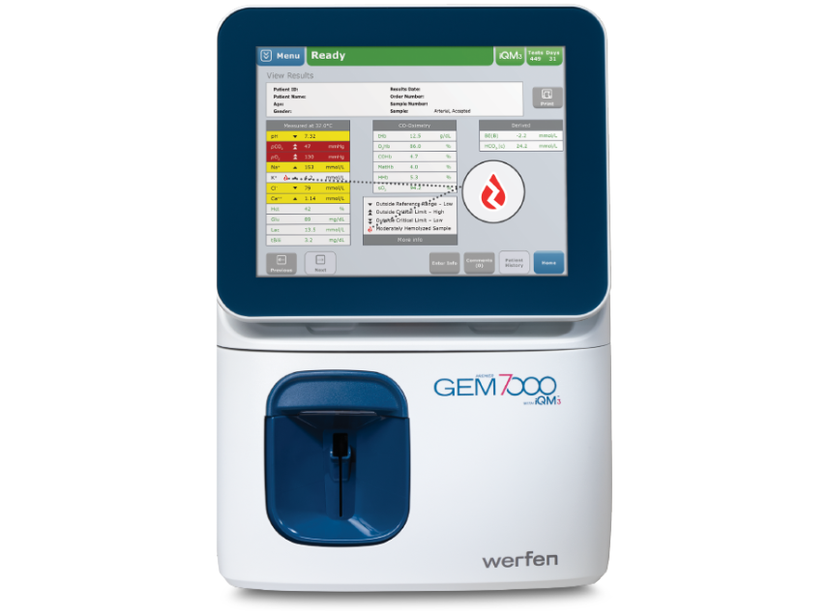Werfen unveils GEM Premier 7000 with iQM3 blood gas testing system at ADLM Annual Meeting
Introducing hemolysis detection in point-of-care blood gas testing for the first time
1 Aug 2024
GEM Premier 7000 with iQM3 blood gas testing system
Werfen has announced the introduction of the GEM® Premier™ 7000 with Intelligent Quality Management 3 (iQM®3) at the Association for Laboratory Medicine (ADLM) Annual Meeting (formerly the American Association for Clinical Chemistry), which has received 510(k) clearance by the US Food and Drug Administration. The GEM Premier 7000 with iQM3 represents a breakthrough in blood gas testing, offering hemolysis detection for the first time at the point-of-care (POC).
As the number one source of preanalytical error, hemolysis accounts for up to 70% of all such errors.1 Despite its prevalence throughout different areas of the hospital, hemolysis is not visible in whole blood, and can go unrecognized. Hemolysis occurs when red blood cell membranes rupture, causing cellular contents to leak into the surrounding fluid, which can elevate potassium results up to 152%.2 In samples impacted by hemolysis, low potassium levels can appear normal and normal levels can appear high. Consequences of in vitro hemolysis can include inappropriate patient management, increased length of stay, and increased costs, among others.3-7
“While hemolysis in point-of-care testing has been widely recognized as a significant problem, and the potential value of its detection tremendous, most have viewed this as an unsolvable challenge—until now. We are exceptionally proud to have solved this challenge with the patented technology in our new GEM Premier 7000 with iQM3 system,” said Remo Tazzi, Vice President Worldwide Marketing and Service at Werfen. “Feedback from our initial customers has been very positive, and we look forward to expanding placements of these new systems throughout the US, and ultimately, the world, to enhance both patient care and efficiency.”
“Every day our clinicians make critical decisions, based on potassium measurements. Knowing whether a blood sample is hemolyzed is crucial for interpretation of potassium results,” said Heather Stieglitz, PhD, D(ABCC), Co-Director of Clinical Chemistry and Point-of-Care Testing, The Ohio State University Wexner Medical Center, Columbus, Ohio. “While we have had the capability to detect hemolysis in a central laboratory, it was missing at the point of care. The GEM Premier 7000 closes this gap, and we are confident that our potassium results will allow clinicians to make safe and rapid decisions for the care of our patients.”
In vitro hemolysis is prevalent throughout the hospital. In neonatal intensive care units, up to half of whole blood samples have been shown to be hemolyzed, while in emergency departments, approximately 20% can be hemolyzed.1,8–10 Undetected hemolysis can lead to inappropriate or delayed treatment, unnecessary redraws, increased staff time, and higher costs.3-7
The system’s hemolysis detection is based upon patented acoustofluidic technology for plasma separation, combined with photometric determination. In just 45 seconds, the GEM Premier 7000 detects hemolysis, while delivering a complete menu of results (pH, pO2, pO2, sodium, potassium, ionized calcium, chloride, glucose, lactate, hematocrit, total hemoglobin, total bilirubin and CO-Oximetry (tHb, O2Hb, COHb, MetHb, HHb, sO2).
iQM3, a real-time, automated, quality management system, continuously ensures sample quality across the most common preanalytical errors, including hemolysis, micro-clots, bubbles and lipemia. It automatically checks sample integrity before, during, and after every analysis, and corrects and documents errors. This helps assure quality results and compliance, 24/7, and informs and expedites critical decision-making.
The all-in-one GEM PAK cartridge automates labor- and skill-intensive processes and offers a variety of menu and test-volume configurations, tailored to the clinical setting. GEMweb Plus 500 Custom Connectivity simplifies control and compliance, enabling comprehensive management of all systems, operators, and data oversight. Its sample handling reports help identify operator competency gaps and training needs, for continuous quality improvement.
The GEM Premier 7000 with iQM3 system is the latest innovation in Werfen’s long line of GEM Premier blood gas testing systems. The most recent, previously introduced model is the GEM Premier 5000 with iQM2, which introduced IntraSpect™, performing continuous quality checks during sampling, in addition to before and after every sample.
The GEM Premier 7000 with iQM3 system is not Health Canada-licensed. It is not available in all countries.
References
1. Lippi G, Salvagno GL, Favaloro EJ, Guidi GC. Survey on the prevalence of hemolytic specimens in an academic hospital according to collection facility: opportunities for quality improvement. Clin Chem Lab Med. 2009;47(5):616–618. doi:10.1515/CCLM.2009.132.
2. Lippi G, Plebani M, Di Somma S, Cervellin G. Hemolyzed specimens: a major challenge for emergency departments and clinical laboratories. Crit Rev Clin Lab Sci. 2011;48(3):143–153. doi:10.3109/10408363.2011.600228.
3. O’Hara M, Wheatley EG, Kazmierczak SC. The impact of undetected in vitro hemolysis or sample contamination on patient care and outcomes in point-of-care testing: a retrospective study. J Appl Lab Med. 2020;5(2):332-341. doi:10.1093/jalm/jfz020.
4. Phelan MP, Ramos C, Walker LE, et al. The hidden cost of hemolyzed blood samples in the emergency department. J Appl Lab Med. 2021;6(6):1607–1610. doi:10.1093/jalm/jfab035.
5. Phelan MP, Hustey FM, Good DM, Reineks EZ. Seeing red: blood sample hemolysis is associated with prolonged emergency department throughput. J Appl Lab Med. 2020;5(4):732–737. doi:10.1093/jalm/jfaa073.
6. Wilson M, Adelman S, Maitre JB, et al. Accuracy of hemolyzed potassium levels in the emergency department. West J Emerg Med. 2020;21(6):272–275. doi:10.5811/westjem.2020.8.46812.
7. Milutinović D, Andrijević I, Ličina M, Andrijević L. Confidence level in venipuncture and knowledge on causes of in vitro hemolysis among healthcare professionals. Biochem Med. 2015;25(3):401–409. doi:10.11613/BM.2015.040.
8. Nichols JH, Apple FS. Prevalence of hemolyzed results in acute care settings. J Appl Lab Med. 2023;8:431-434. doi:10.1093/jalm/jfac141
9. Tóth J, Oláh AV, Petercsák T, et al. Detection of haemolysis, a frequent preanalytical problem in the serum of newborns and adults. EJIFCC. 2020;31(1):6
10. Khedr S, Blake V, Erdogan E. Neonatal unit hemolysis rates from an academic medical center: A quality improvement project. Arch Path Lab. 2016;140(6):502-503. doi:10.5858/arpa.2015-0252-le
Want the latest science news straight to your inbox? Become a SelectScience member for free today>>
